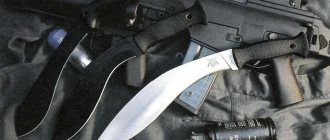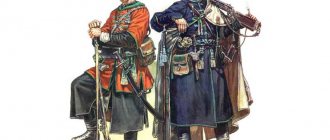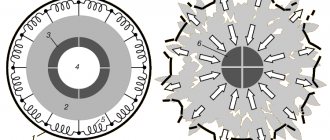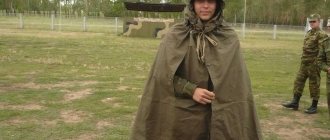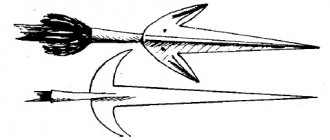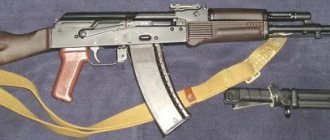The whip is the national weapon of the Cossacks. A whip is a flexible striking weapon , also used as a whip to control a horse.
The word "whip", according to one version, comes from the name of the khan of the Golden Horde - Nagai , the great-great-grandson of Genghis Khan, whose tribe was engaged in breeding cattle and horses, and also carried out regular raids. To control horses more easily, as well as to strike, the nomads used whips called whips.
According to another version, the name comes from the word “naga”, which in Sanskrit means “snake”, which is probably due to the special weaving of the whip, reminiscent of snake scales.
There is also a version of the origin of the name associated with the place where the whip was worn - behind the top of the boot (next to the leg), and therefore it gradually began to be called a whip.
In the tradition of the Russian Cossacks, the whip is closely connected with Cossack Spas , an ancient national martial art, being one of the main weapons of close combat. However, the whip, unlike, for example, a checker, was used only when it was only necessary to neutralize: to stun or immobilize the enemy, but there was no goal to kill him.
The whip accompanied the Cossack throughout his life. It was hung over the cradle of a newborn baby and placed in a coffin, along with a saber, when the Cossack died.
It was believed that the whip was a powerful amulet that protected against evil spirits, so a whip was placed over the head of unbaptized babies.
Also known since ancient times, it was a tradition, as a sign of special respect and favor, to throw a whip at the feet of an arriving guest, which was equivalent to bowing to the ground and was considered the highest degree of hospitality.
There was also a tradition of exchanging whips, which was a confirmation of peace, a manifestation of the highest friendly feelings and mutual respect.
Researchers call two types of ancient weapons the predecessors of the whip in Rus':
Flail , which is a short stick, on one side of which a metal ball with sharp teeth was attached to a short belt or chain, on the other - a lanyard (hand loop) and
Shalapugu - a fighting whip with 20 braids and a thick whip, at the end of which a metal bar was attached.
Kisten and Shalapuga, according to historians, were used by the Slavs against the raids of nomads, before the advent of firearms. And only with the advent of firearms they were replaced by whips.
There are several types of whips, depending on the region of manufacture and design features. The most famous are the Don and Kuban whip.
History of creation
There are two versions of the origin of the word “whip”:
- From the name of the North Caucasian people - Nogai (by analogy, Circassians - Circassian). However, the exact etymology of the concept “Nogais” has also not been established. Most often, the word is associated with the Golden Horde Khan Nogai (or Nagai) (from the Mongolian noqai - “dog”), the great-great-grandson of Genghis Khan.
- From the Sanskrit "naga", meaning "snake". And, indeed, the weaving of the whip resembles the scales of a reptile. In this regard, it is worth mentioning Yegor the Brave or St. George the Victorious - a saint especially revered by the Cossacks, and generally considered the heavenly patron of Russian soldiers. According to early legends about Yegoria, he defeated the snake with a word and tamed it.
It is impossible to say exactly when such a weapon as a whip appeared.
The earliest mention of it can be found in the works of the Roman historians Herodotus, Pompey Trogus and Polyenus, who told how the Scythians, returning home from a multi-year campaign, were forced to fight their own slaves (or their sons), and victory was won with the help of lashes
Reference. The Scythians are Iranian-speaking tribes, whose possessions in the 7th century BC. e. stretched from the Danube to the Don. The Scythians have nothing to do with the Slavs. Of the modern nationalities, the Ossetians are closest in language to these Aryan tribes. The ancient Iranian "danu" means river, water; Ossetian “don” – river. The whip was used by Kazakh, Tatar-Mongol tribes.
The evolution of the whip in Rus' is associated with ancient weapons - the flail and the shalapuga: they were its predecessors.
The first was a short stick, on one side of which a metal ball with sharp teeth was attached to a short belt or chain, and on the other - a lanyard (hand loop).
The Slavs used the flail against the warriors of the Khazar Khaganate. It could easily be grabbed while galloping and quickly attack the enemy: it would pierce helmets and armor.
Following the flail, a shalapuga appeared - a fighting whip with 20 braids and a thick whip, at the end of which a metal bar was attached. It was used by the Slavs against highly annoying nomads, whose “uniform”, unlike the heavy Khazar armor, was leather with metal plaques sewn onto it.
When firearms began to be used in battle, the need for shalapugas disappeared, and whips appeared instead.
The whip was used in close combat most often when the main weapon (rifle, saber, pike) was lost.
With the help of a whip it was possible to deliver a strong blow (rarely fatal) and stun the enemy.
The whip was used mainly for driving horses, as well as for punishing subordinates, for educational purposes for the younger generation, and in rituals. There is a well-known Cossack custom when, as a sign of special respect, a whip was thrown at the feet of an entering guest.
If he raised it, it served as a sign that he was well disposed towards the owner of the house. If the visitor was offended and wanted to show dissatisfaction, he stepped over the whip.
Options and principles for using a whip
| Scope of application | Purpose and features of the whip |
| Agriculture | Forcing animals in agriculture and cattle breeding. Cattle are frightened by the click that the whip makes or react to the blows. |
| Punishment system | A tool for carrying out the most severe and cruel types of punishment for people. A well-placed blow of the whip cut the skin and nearby tissues to the bone. After 10-15 such blows, the whip became damp with blood, so it had to be changed. |
| Cavalry equipment | Element of horse control, as well as an effective auxiliary weapon. |
| Hunting | The rider's main tool for many methods of horse hunting for various game, from hares to wolves. |
| Animal training | Currently used by circus trainers for various animals, as well as by dog handlers. |
When striking, the tail of the whip, thinned towards the tip, is capable of developing supersonic speed. The blow of a fairly flexible whip produces a characteristic sound, similar to a click. The damaging property of the whip could be enhanced by special weights on its tip. A similar design was sometimes called a “Roman scourge” (in Rus' it was more often called a “flail”) and was in service both in the ancient Russian squads and in the Mongol horde.
Warlash
The damaging property of the whip could also be purposefully weakened, so as not to injure the horse’s skin with an excessively strong blow when riding. For these purposes, the whip was equipped with a relatively wide leather plaque (“slap”) at the tip, or, as an option, the tip was made from several tails.
In Domostroi, the whip was indicated as an instrument of domestic punishment. Among the most important ritual rites, the following can be noted: on the wedding day, the groom had to put a whip in his boot as a sign that marital power in the house belonged to him. This ritual is still reflected in the traditions of the Cossacks, distinguishing a married Cossack in combat.
The whip served as an instrument of punishment (including judicial) within the established class system. The grounds for imposing such punishment were quite serious crimes, including murder and participation in a riot. Whips eventually became a lighter version of the whip and were also used for less severe public punishments.
Don Cossack whip
What is a whip and its varieties
In Russian military practice, arapniks and whips have become a special type of weapon. During the 19th century they became the distinctive type of auxiliary weapons of the following military formations:
- Cossack troops;
- The so-called “foreign” cavalry units from representatives of nomadic peoples;
- Mounted Gendarmerie units.
In the latter case, the whip was widely used during the suppression of riots and to disperse demonstrations. And among the Cossacks, whips have long been used to punish the guilty Cossack.
The Russian language dictionary defines the term “whip” as a “short belt whip”.
The main version of the origin of the word “whip” is considered to be a colloquial version of the term “Nogai whip”, based on the use in the design of the Cossack whip of elements borrowed from the so-called “Nagais” (“Nogais”) - tribal formations of nomads under the rule of one of the rulers of the Golden Horde, the khan Kicking. There is also a version associated with the word “naga”, which in Sanskrit means “snake”, and the most ancient and simplest method of weaving whips was called “snake” and looked like the scales of these reptiles.
In general, a whip is a tight weave of leather straps with a special bag at the end, into which a weight can be placed to enhance the blow. This weapon is very compact, its impact has enormous speed, which is extremely difficult to react to, and causes a severe painful shock in the enemy.
Initially, many Cossack whips were double-tailed: one of the whips (reinforced) served as a weapon, the other was intended for controlling a horse. The unused type of whip was fixed with a special clamp. In 1839, by order of the military department, whips were streamlined as an element of Cossack weapons, which established their exclusively single-tailed variety. At the same time, a number of traditional differences in the types of whips have been preserved to this day.
The whip was used most often in close combat, moreover, in the case when the main weapon of the Cossack (rifle, saber, pike) was lost. In general, the whip was used to stun the enemy, and experienced warriors could use it to deliver a fatal blow or pull the enemy rider off his horse.
Combat whips, as a rule, were attached to the wrist, while allowing free use of the hand. In Cossack whips, this role was played by a lanyard - a loop for the wrist, which made it possible to firmly hold the whip. In addition, at the beginning of the handle there was usually a built-in metal tip (shalyga), which served to strike directly with the handle.
- Donskaya. The Don whip has a ring (metal or belt) at the end of the handle 30-40 cm long, to which the whip itself, 1.5-2 meters long, is directly attached, which makes the blow sharper.
- Kubanskaya. The Kuban whip has a relatively short (about 20 cm) handle, which is braided with leather, smoothly turning into the main weave. The junction of the tail of the whip with the handle is not visually distinguishable. This type of nut is better suited for delivering snap blows.
- Ural. It is considered a type of Kuban whip, in contrast to which it has a pommel instead of a wicker “apple”. Handle length - 15-20 cm, whip length - 50-75 cm.
- Statutory. It is considered a type of Don whip for the army of the Russian Empire. In accordance with the decree of Alexander III, all Cossacks were armed with statutory combat whips, regardless of rank: from private to general.
- Zaporozhye. It is considered a type of Kuban whip.
- Arapnik. A long hunting or training whip with a thin and durable beam (made of hemp, silk or horsehair), placed on a short whip. All whips are considered a shorter version. The term “arapnik” itself arose from a distorted Polish name for the whip, derived from the German “herab” (“away”).
- Volchatka. A type of arapnik with a rigid handle, designed for hunting wolves and foxes on horseback. The length of an ordinary wolf cub is about one meter. The striking part has a thicker weave, and a weight is attached to the end for greater penetrating force. Due to the similarity of the basic parameters with the Cossack whip, it is often synonymous with this weapon.
- Tatar Kamcha. A thin single-tailed whip with a thin whip. Traditional Tatar kamcha often refers to a variety of the Don type whips.
- Belt whip. A general concept that unites types of whips of different types. This also includes special designs, for example, a variety of Kalmyk whip “tashmg”, which was made not by interlacing narrow leather straps, but by stitching several relatively wide strips of rawhide with a thin leather cord-thread.
Scorpion King
In addition to the classic combat flails, the Hussites used a type of multi-tailed flail-scourge called a “scorpion”: a long shaft and 3-4 massive chains without strikers at the ends, but several decimeters long. The name of such a scourge comes from the name of the ancient Roman multi-tailed whip. True, the Roman “scorpions” were so called for the sharp bones woven into the belts, leaving “biting” wounds, and the medieval versions, intended for striking chain mail (real armored men at arms were rare in the then Czech Republic), acted differently, transmitting the energy of the blow through the pierced armor. Finally, it is worth mentioning the tank “scorpions” of the 20th century, so named for their resemblance to the weapons of the Hussites and intended for “threshing”... a minefield.
Japanese kusarigama is a flail combined with a scythe. The enemy could be entangled in a chain and finished off with a blade
It seems that it is from the battle scourges of the eastern horsemen of the early Middle Ages - the Avars, Khazars and Arabs - that those European and Russian flails, which are akin not to a sectional flail, but to a flexible multi-link “inertia” topped with a compact kernel, directly or indirectly trace their ancestry. And the whip of the Nogai Horde, that is, the whip, is also a late offspring of this steppe family.
“The flail in the east is called a buzdygan, in the west - a morning star, and here, in the middle, it’s just a flail. Zhikhar made it with his own hands. The shaft was carved from a strong oak branch. I drove an iron hole into the round end, having previously threaded the end of that princely chain into it - it came in handy once again. The ends of the breakout that came out of the shaft were carefully bent upward and hammered, and I also wrapped this place with a piece of strip iron for good measure. I tried it out for a swing and shortened the chain. I made another breakdown into the last link, bending its ends to the sides. He dug a round hole in the clay and carefully smoothed it out from the inside. Then he stuck about two dozen thick cast iron fragments into the clay <…>. The end of the chain was lowered into the hole. He begged the owner for lead, which he used to seal all sorts of nasty things in vessels. He melted the lead in a pot and poured it into a hole, and when the lead cooled down, he jerked up the finished weapon, twirled the skinny ball over his head and was satisfied: this could easily break the head of even a bear. You can do it both for your comrade and for yourself, if you handle it ineptly.”
Mikhail Uspensky “Where we are not”
Bogatyr Zhikhar made a slight mistake: both in the manufacture of the warhead (oh well, one blow is enough, but then the chain, lead and cast iron fragments will continue to exist separately from each other - so much the worse for them), and in the name. An ordinary buzdygan, like an ordinary morning star, is more of a club. The flail in Rus' was more often called “bassalyk” - also with an eastern accent. Among the Turkic-speaking peoples, this is the name given to a weapon with a flexible connecting part, just like a weighted whip.
Multi-bladed Indian urumi, a rare and very dangerous weapon for the owner
In the Middle Ages, wooden simulators for horsemen, working on the flail principle, were common. Traditionally they were dark-skinned, dressed in a turban and were called “Saracens” or “Moors”. Such a simulator looks like a dummy mounted on a rotating pole, in the left hand there is a shield, in the right there is also a flail, but more often - a brush on a multi-link chain, sometimes even a three-tailed one. After the mounted spearman hits the shield at full gallop, the Saracen rotates around its axis, and the cavalryman has to perform the second part of the exercise - to dodge the flail lashing after him.
In India, large fighting flails are rare, but small, multi-tailed ones (five or even seven chains with light “clawed” weights at the end) are much more common. But all these tails are not connected to the shaft at one point, but are distributed along a T-shaped crossbar. As a result, the handle of such a flail resembles a rake. The affected area increases; True, the concentration of force, speed and maneuverability are falling - but this game, according to the Indians, is worth the candle if you bet on contact with a poorly protected enemy.
Hindus train to fight with urumi, whip swords. The urumi whip is made of a very thin and flexible strip of steel - it can be used to both cut and whip. Such weapons are common in the Indian state of Kerala
The stone is the tip of a Maori mace-mere. There could be a handle at the other end of the rope - or there might not be, then the fighter simply wrapped the rope around his hand
Polynesia is the homeland of war clubs. There, even the spear often dies out: various types of clubs occupy the entire weapon niche from brass knuckles to pikes. There are whips among them even without five minutes. Such, for example, are small (intended for close combat) Maori clubs-mere, shaped like... a violin. When they work like a club, they hold it by the “violin neck”, to which is usually attached a long and strong lanyard loop, which allows them to strike in a fist-style manner.
As the main weapon, these flail clubs disappeared back in the 19th century, but they were used as an auxiliary weapon even during the Second World War! New Zealand Maori soldiers willingly took small compact measures with them into the army, hoping to use them in jungle battles, when removing sentries, and so on. It is curious that in modern New Zealand the law is very strict on the carrying and use of any type of bladed weapon - and in the self-defense schools that exist there, instructors teach the rules of using such “safe objects” as a piece of laundry soap in a sock or a stack of coins in it. In fact, all of these are flails!
New Zealand “fiddles” were hewn entirely from stone or, even better, from whale bone, but this specificity could not take root outside Oceania. Often the material for the tips of combat whips is metal - preferably bronze, which has the optimal combination of strength and specific gravity, but sometimes iron or lead. It happens that such a striker only has a metal “core” and a leather shell - in fact, we have a bag with a weighting agent inside. Bone, not just whale bone, is also an acceptable material, but it is not always possible to find a suitable blank (in science fiction, of course, there are more possibilities: here a dragon vertebra and a mastodon tusk can be used). The same applies to stone: let’s say, jade is very good, but is it available, and if so, will it be possible to process it?
The flails of Muscovite Rus' in a combat situation were clearly inferior in importance to the bow and saber - but were approximately equal to the mace and small axe. The whip of the first rider is clearly visible
In Rus', the base of an elk horn worked well as a striker. In the early period of ancient Russian history, this was generally the main material for combat flails; it gave way to metal only with an increase in the level of armor. But wood is used extremely rarely, even if it is hardwood and burl. True, in Novgorod epics Vasily Buslaev fights with a “scarlet elm”, which apparently means imported mahogany (from the side of the mayor’s son this is not just “show-off” - this material has a high specific gravity and remarkable strength). This “elm” in different descriptions appears either as a staff or as a “strapped club”, that is, a flail - although more likely of a flail, sectional type.
In Novgorod, both “fist clubs” and corresponding flails are generally well known. This, of course, is a violation of the rules, but it is familiar and expected. And in some cases, it seems inevitable: for example, when the results of evening voting are recounted and voters decide the issue “wall to wall” with particular fervor. Under similar circumstances, flails were used in the Zaporozhye Sich - as a last resort means of “election campaigning” and “administrative resource”, allowing to avoid the use of frankly lethal weapons like a saber, the exposure of which was still considered lawlessness and could lead to the disruption of the elections.
How the whip works
The main parts are the handle and the whip, each of them includes several elements.
Handle:
- grip - a place covered with leather braiding to make it comfortable to hold in the hand;
- Shalyga – a metal tip that was placed at the beginning of the grip. It was used to strike directly with the handle;
- lanyard - a loop for a brush, which allowed you to firmly hold the whip;
- plant - loop for a whip;
- reinforced (i.e. fastening) for a strong connection between the handle and the whip. It was a thin strip of leather wrapped around the end of the handle;
- hook - a ring for connecting the handle and the whip;
- dolon - leather flap.
Scourge:
- terry made from leather ribbons;
- sarven – intertwined belts;
- slap - a leather pouch at the end of a braid in which a metal part could be placed.
A whip without metal weights and a cable does not belong to the category of impact-crushing weapons and does not fall under the articles of the Criminal Code.
Weapons from improvised means
— How to arm yourself with what you have at hand.
I had heard about wolf cub before, but this was my first time seeing what it was like. Convenient and effective means of self-defense. The new is the well-forgotten old.
Good day! Please tell me, are your products equipped with any permitting documentation, such as a certificate of conformity (about what is not a chemical substance)?
When buying a vacuum cleaner, do you also require such a certificate? What about a hammer?
In fact, lupus does not have signs of a chemical weapon and is not a chemical weapon for its intended purpose. So she needs a certificate just like a hammer.
The whip can be carried completely unnoticed by placing the handle in the inner pocket of the jacket and passing the rest into the sleeve. And so - thanks for the video - everything is explained clearly
Weaving features
The product uses classic eight-strip weaving - the “gold standard” for whips. If you use fewer strips of leather, the whip will be too hard and rough; if you use more, they will be too thin, and the end result will be the same. Whips made of 10 or more strips of leather are more likely to be decorative, while our product is fully functional and suitable for practical use.
For production, high-quality black calfskin is used, processed using modern technology. It is much stronger than “raw leather” (leather tanned in the old way), so this whip will faithfully serve you for a long time, even with active use.
Use of the whip among nomadic peoples
In the legends and tales of nomadic peoples, whips are constantly mentioned. Arapniks and whips were used by hunters and shepherds. The warriors used the whip. The “naked fight” was very popular among the Kyrgyz, when naked riders with whips tried to knock each other out of the saddle. Everyone is divided into teams and, as in a real battle, they help each other. The use of the whip taught Kyrgyz warriors the ability to fight with any available object. The Chinese in the second century BC experienced the lashes of the Kirghiz.
The steppe warriors developed a system of whip fighting, in which the emphasis was placed on striking pressure points. Moreover, the blows were applied not only with the whip itself, but also with the handle. In folklore, there is often a special blow to the head, from which “the head flew off the shoulders.” It’s difficult to say now whether this is true or not, but an experienced shepherd even today can break a wolf’s back with one blow of his whip.
Emergency use
If you are right-handed, then thread the whip through the belt loops so that it wraps around you from left to right. The handle should be on the left side, and the slap with the loop should be on the right. The fastener will be approximately in the center, in place of the belt buckle.
To grab the whip, simply unfasten the button with a short movement, put your hand on the “Turkish head” and pull out the whip in one movement. Since it tapers towards the tip, it is easy to remove. To swing, just one turn of the hand is enough - and now the whip in your hand is ready to attack any target.
How to make your own arapnik
Making a whip with your own hands, including in the form of a traditional Cossack whip, is not something difficult. This ancient military weapon can be made using fairly modern materials, based on diagrams and practical recommendations.
Making your own arapnik begins with making a handle. For this, hard wood varieties are traditionally used - beech, oak, ash, acacia. In general, the material of the handle should be strong, but light, so it is also permissible to use textolite or ebonite, but light metal alloys, on the contrary, are not recommended. To prevent the handle from becoming too thick, before braiding it is necessary to reduce its diameter by an amount that is equal to the thickness of the strips of leather used for braiding.
The classic requirement when making whips is to use natural rawhide, preferably cowhide, as raw material. Belts prepared for weaving must first be soaked in ordinary water: the weaving process will become much easier as a result, and after the leather has dried, the weave will become stronger.
Those who want to correctly determine the size of the whip according to the standards of the Kuban-type whip can do it this way: extend your hand in front of you and rotate the whip in a vertical position. The whip should not reach the face of the driver.
The weaving of the whip-arapnik is made in two main types: regular or with a laid core (vitem). The presence of a core makes the whip less flexible, but enhances the blow, which is why such whips were most often used for hunting or fighting.
Weaving with vitna
In patterns of this type of weaving (for any classic type of arapnik, including a whip), horsehair is traditionally used as the core. In modern conditions, it is not easy for many to obtain it, so a nylon cord attached to the future handle is quite suitable for the base. The strips are screwed to the base so that those that go from left to right are wound first, and then the opposite ones. The end is secured with threads.
Regular weaving
Braiding without the use of a core is, in fact, reminiscent of weaving a regular braid. Leather strips for weaving are cut using a regular stationery knife, forming a narrowing towards the tip, and processed with an edge cutter. There may be 4-6 stripes, but for a “classic” whip, 8 are recommended, and for a “reinforced” whip – 10, 12 and even 14.
The shape of the slap (a leather bag at the end of the striking part of the whip, into which a weight is placed to enhance the blow) is recommended to be trapezoidal, which is considered the most convenient shape. It is better to make a slap for a whip not in one piece, but with lace. If necessary, a weight can be placed in the resulting pocket, which can be a piece of lead or a bullet approximately corresponding to a 5.45 mm caliber.
Scourges in Antiquity
The surviving works of Greek historians bring to us interesting facts about the use of whips. In addition to using whips to punish offending slaves, the Greeks, noticing how the Scythians skillfully wielded arapniks, hired them as keepers of order. Several wild Scythians with whips quickly dispersed the crowd, which was tens of times larger than them. At the same time, the whip was a more humane weapon than the modern batons of riot police.
The battle tactics of the nomadic tribes of that era looked like this:
- At first, the opponents fired at each other with bows;
- Then the spears went into battle;
- Swords and axes were used in close combat (daggers were used as a last resort).
Since the swords of those times were short, where it was impossible to turn with a spear, whips were used. The blows of the whip affected not so much the enemy as the enemy horses. Sharp blows of the whip not only knocked out eyes, but also tore clothes and skin. It was the whips that influenced the development of full Sarmatian armor, since blows from flexible weapons were unpredictable, and it was not always possible to hide from them behind a shield. Famous warriors of that era fought off arrows and darts with arapik. If at long distances the warriors of the steppes used lassos, then at short distances they were successfully replaced by whips. With a deft blow one could snatch an ax or sword from the enemy’s hands. Some warriors became so familiar with whips that they could use them as a sling.
Cultural significance
In late Cossack society, the whip was a sign of the status of a full-fledged adult combat Cossack. In some villages, by the way, it was exclusively married (given by the father-in-law to the son-in-law at the wedding), but not in all.
The whip was usually hung in the house on the door frame, on the left. She was considered something of a mascot for the house. For example, during a quarrel, the owner could throw his whip at the feet of the offending guest. If he picked up the whip and handed it back to the owner, it meant that he wanted to reconcile and not make a fuss.
But if the guest simply left, and worst of all, stepped over the whip, such a vendetta could begin that where were the wimpy Italians Montagues and Capulets.
How to work with a top
In terms of style of work, the wolf is closer to the checker and flanking.
Here is an example of such work with a top.
Very often, when learning to work with a checker, the student is first given a top and with it he practices flanking techniques. This is due to the fact that if the exercise is performed incorrectly, if the student hits himself, he will only receive painful sensations and this will force him to act carefully; when working even with a training saber, such a blow leaves abrasions and can cut the skin.
Having mastered flanking with a top, you can easily repeat the same exercises with a checker. But you will have to learn how to work with a whip, because the whip is softer and more flexible.
However, for simple self-defense there is no need to memorize complex techniques or develop flanking techniques for years
Here are simple techniques for using the wolf claw against attackers, please note that even neat demonstrative spankings with the wolf claw are very painful




